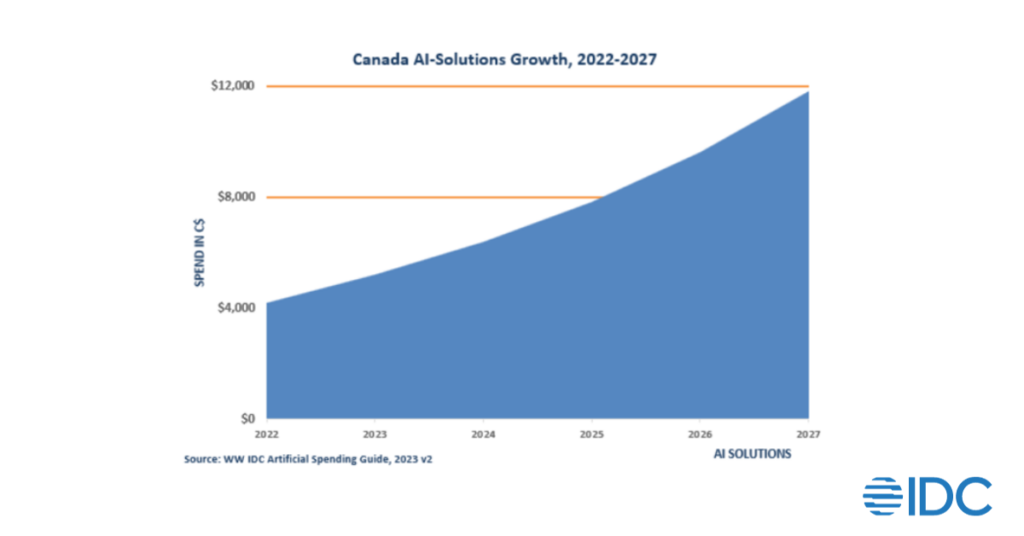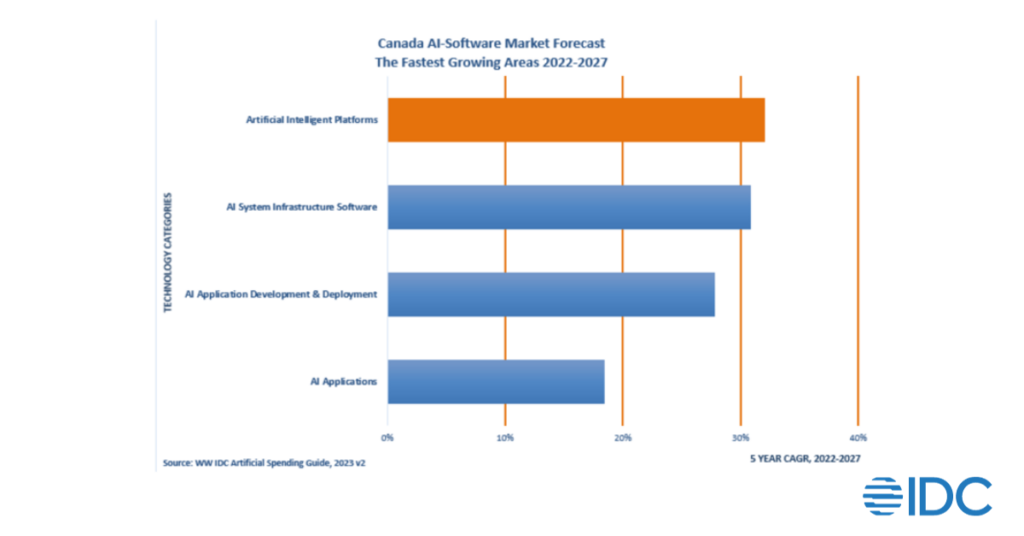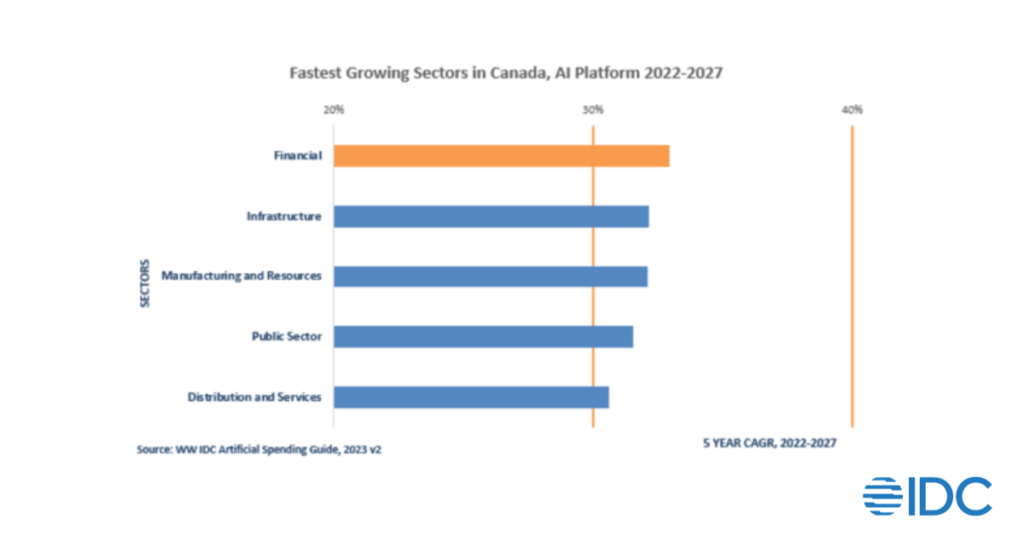Since the launch of ChatGPT in November 2022, the media has been abuzz with all things Artificial Intelligence (AI), specifically with the concept of Generative AI. Even though these terms are decades old, at this point, it is safe to say that AI has come a long way. More recent advances in machine learning and deep learning have enabled computers to perform tasks that were once thought only to be wholly within the domain of human reasoning.
According to IDC’s most recently published Worldwide Artificial Intelligence Spending Guide – which tracks the artificial intelligence (AI) spending for software, hardware, and services across industries and use cases – Canadian enterprises are expected to invest about C$ 5.2 billion on AI solutions in 2023. From 2022, this amount is expected to grow almost three-fold by 2027 at a compounded annual growth rate (CAGR) of 23.03%.

Further, IDC expects the AI platforms, which includes technologies such as Conversational AI tools – the set of technologies behind automated messaging (text) and speech-enabled (audio) applications that offer human-like interactions between computers and humans – to cross more than C$2.2 billion, growing at a CAGR of 32.05% by 2027.

Chatbot 2.0 Wars – Fueled by AI
Media buzz aside, one of the most exciting areas of AI research is Generative AI, which uses algorithms to generate new and unique content based on patterns and relationships learned from vast amounts of data. At its core, GenAI involves teaching a machine learning model to generate new content by training it on a dataset of existing content.
ChatGPT stands for Chat Generative Pre-Trained Transformer, which is a chatbot developed by OpenAI. Both GPT 4 and GPT 3.5 belong to a family of large language models (LLMs) and are fine-tuned with supervised and reinforcement learning techniques, which are used by ChatGPT. Since GPT-4 is the newer of the two models, it comes with enhanced upgrades and improvements compared to its predecessor, GPT-3.5.
The ‘large’ in LLM refers to the number of values or parameters used; to put things in perspective, OpenAI’s GPT-3.5 used approximately 175 billion parameters and was limited to information prior to June 2021 whereas GPT-4 is based on a lot more training data of over 1 trillion parameters and its data cut is up to September 2021. This gives the latter greater ability to handle much more nuanced instructions than its predecessor. Another stark difference between the aforementioned versions of ChatGPT is that GPT-4 is a multimodal model, which means it can process both text and image data, whereas GPT-3.5 is a text-to-text model.
Microsoft, for its part, has also introduced ‘Bing Chat AI,’ uses GPT-4, an iteration of ChatGPT’s language models, combining web search, browsing and chat into one unified experience, producing more reliable and precise data compared to ChatGPT versions.
Following suit, Google released its generative AI chatbot, BARD, earlier this year. BARD was initially based on company’s own LaMDA (Language Model for Dialogue Application System), but now uses the language model called PaLM or Pathways Language Model, which is more advanced and uses about 540 billion parameters. More recently, Google announced it is nearly ready to release its next-generation AI foundation model – Gemini – which is anticipated to outplay many of its competitors.
Other big players such as Amazon and IBM are not far behind in this space and have made some notable announcements. Amazon’s proprietary LLM foundation models are known collectively as Amazon Titan and would be available through Amazon Bedrock service and other third-party companies. IBM, on the other hand, announced recently announced new GenAI foundation models and enhancements coming to WatsonX – the company’s AI and data platform.
Canadian AI Market Opportunities
Given the recent innovation around the Generative AI space, IDC Canada expects that the next five years will be crucial in the adoption of AI-enabled software; businesses and enterprises of different sizes, as well as Federal and Provincial Governments, are expected to be obvious adopters. They are likely to adopt such technologies to stay AI relevant, but more importantly to create efficiencies, bolster automation, and remain agile.
As per IDC’s Artificial Intelligence Spending Guide, Canada’s top three fastest-growing sectors in the Artificial Intelligence Platform space are Financial, Infrastructure and Manufacturing & Resources.

Generative AI Limitations
While GenAI has shown incredible potential in a wide range of applications, several limitations must be considered when using this technology. Some of the most significant limitations of GenAI include:
- Lack of control over output: Since the AI algorithms can produce original content, it isn’t easy to control the specific output.
- Overfitting: too focused on specific data.
- Limited dataset for learning: “You only know what you know.”
- Bias loop: unfair or inaccurate output if the training data is biased.
- Ethical concerns: deepfakes, copyrights, etc.
While these limitations are significant, they do not negate the potential of GenAI. In fact, these conversations about GenAI will help further increase AI awareness and an AI uptick in general.
Conclusion
As with any technology, challenges and ethical considerations must be addressed as the field of GenAI continues to evolve. And with GenAI’s benefits becoming ever more apparent, its impact on our lives and businesses will only continue to grow – making the conversations about its ”correct and fair” use of utmost importance. Overall, the versatility and potential of GenAI make it a very fascinating area of research, with many exciting developments and applications yet to be realized. Stay tuned.
For more information on navigating the Canadian and global AI markets, refer to the following links or contact us today to learn more about IDC’s AI and GenAI data and analytics research.
- Worldwide Semiannual Artificial Intelligence Infrastructure Tracker
- Worldwide Artificial Intelligence Spending Guide
- IDC’s Worldwide Artificial Intelligence Spending Guide Taxonomy, 2023
- Generative AI Platforms and Applications: Market Trends and Forecast, 2Q23
- OpenAI Announces Availability of GPT-4 for Improved Conversational Performance
- Worldwide Artificial Intelligence Platforms Software Forecast, 2023–2027




